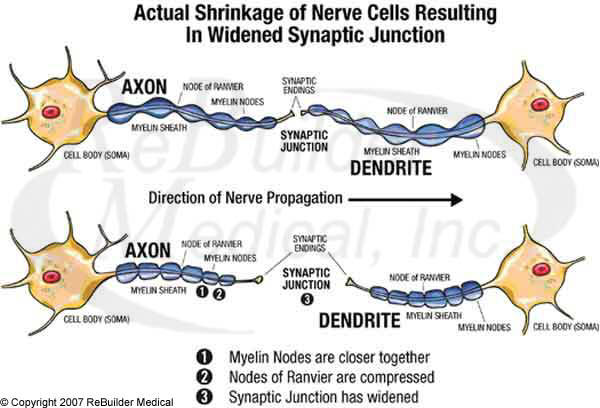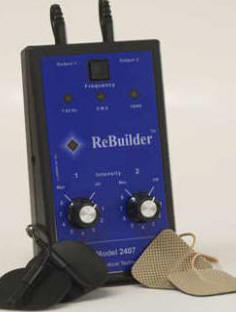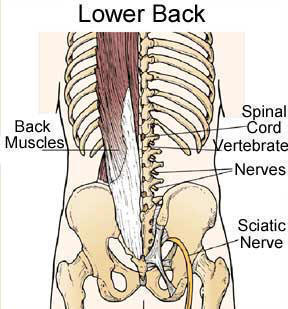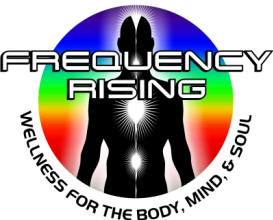Peripheral Neuropathy
- What Is It?
Neuropathy
is defined as a disease (pathos) of the
nerves (neuro). Many symptoms are grouped
together in the catch-all diagnosis. Whether
it is called idiopathic (which means we
don’t know the cause), or diabetic peripheral
neuropathy (associated with diabetes), or poly
neuropathy (which means “in more than one place”),
they all have a common cause. The nerves
have gone to sleep because they have been
deprived of oxygen (anoxia).
Anoxia causes
Neuropathy
When your peripheral
nerves are deprived of oxygen (anoxia), whether it
is because of too much sugar or insulin in your
blood, chemotherapeutic drugs, or toxins like agent
orange, these things can displace oxygen. Sometimes
inflammation in the lower back or sciatic nerve area
of the buttocks can restrict blood flow. Common
drugs like statins (to reduce cholesterol) can eat
away the myelin sheath of the nerves which is
composed mostly of cholesterol. High blood pressure
medicine can cause neuropathy by decreasing blood
flow at the extremities, like the feet or hands. In
order to survive in this oxygen depleted
environment, the nerve cells can shrink
(atrophy) in order to present a smaller surface to
the world and stay alive. Inside your body, each
nerve cell is separated from the adjacent cell by a
synaptic junction and the shrinking of each cell
because of lack of oxygen can increase this gap. A
larger gap makes it harder for the electrical nerve
impulse to get across. With peripheral neuropathy,
once this gap inhibits peripheral nerve impulses,
the minerals that are dissolved in the synaptic
junction's fluid can leach out and this makes the
fluid less effective and less conductive. Water alone does not conduct
electricity very effectively... water needs minerals dissolved in it
to make it conductive.

What is needed is a larger
signal that can cross this synaptic junction,
minerals (electrolytes) to make the synaptic fluid
more electrically conductive, stronger calf muscles
to help local blood flow, and immediate pain relief
from the release of endorphins from the brain.
This is precisely what
The ReBuilder
system’s electrical stimulation is designed
to do!
What
causes lack of oxygen (anoxia)?
Temporary lack of
oxygen to the nerves can be caused by many
different things:
 |
Dramatic
changes
in glucose and insulin in
the blood (diabetes) that
displace oxygen.
|
 |
Side effects from
drugs
such as those for cholesterol, blood
pressure and arthritis that change
the metabolism of the nerves thus
altering the way they use oxygen. (Pravachol, Amytriptyline,
etc.) When prescription pain
killers such as Neurontin (Gabapentin),
Cymbalta, Lyrica, amitriptyline,
oxycodone, etc. are administered,
they do nothing for the peripheral
nerves in your legs and arms, but
they do numb the nerve roots at the
level of the spine. In this way, the
dysfunctional peripheral nerve
signals cannot reach the central
nervous system (brain) thus these
dysfunctional nerve signals are not
perceived as pain. As with most
medications, after a while the body
accommodates to the current dosage,
the dosage then is periodically
increased. This can reach a level
whereby numbness in the extremities
is experienced as well as fuzzy
thinking and loss of proprioception
(knowing where your feet are in time
and space). These symptoms can mimic
Alzheimer's and compound your
medical situation.
|
 |
Toxins
like cleaning solvents, PCBs, metals,
and other environmental toxins that
have a lot of free radicals that
makes oxygen unusable. |
 |
Inflammation in the lower back
which reduces blood flow to the
nerves in the spinal column.
|
 |
Chemotherapy
that affects cancer and other fast
growing or functioning cells like
hair and nerves.
|
 |
Sciatic nerve
entrapment (piriformis
entrapment) caused from
aging, muscles losing tone (becoming
ropy or sinewy), and sitting too
long in one position putting
pressure on the sciatic nerve or its
blood supply. |
 |
Repeated
trauma
such as frostbite, standing on
concrete, or accidents that impinge nerves and change
blood supply to the nerves |
 |
Surgery
complications and prolonged anesthesia exposure. |
 |
Food Allergies
Specifically, the sweetener Aspartame.
This is very toxic to the body,
including nerves and brain. As it
metabolizes in the body, it transforms
into Wood alcohol. (also leads to type 2 diabetes) |
 |
Infections such as parasites, viruses, bacteria
that |
 |
Nutritional deficiencies. Long term poor
diet may not provide the ingredients needed to maijtain
healthy myelin, and some foods may even lead to
premature degrdatio of the myelin. |
 |
A combination of any of the above. |
All these triggers could
result in a reduction in oxygen delivery, poor circulation,
and trauma to the nerve cells. If you sit too long in an
awkward position, you will notice that
your nerves "go to sleep". Once you
move your limb around and restore the
blood flow, the pins and needles and
numbness, even pain disappears. If this
temporary restriction of blood flow
continues too long or too often, this
sensation can turn into neuropathy.
Sometimes
this is because of a lower back or sciatic
nerve problem, and temporary inflammation
has pinched either the nerves, or the blood
supply to the nerves. To survive, these
nerves begin to atrophy (like an unused
muscle) causing them to shrink back a
little. Normal nerve cells do not actually
touch each other, but just get close. The
gaps between them are called synaptic
junctions. The nerve impulses travel along
the body of the nerve cells, and they then
have to jump this synaptic junction to reach
the next nerve. Some nerves may be almost a
meter in length. There are two primary
types of nerve cells: afferent (to carry
sensations to your brain), and efferent (or
motor neurons to direct the movement of your
muscles). Some of these nerves are covered
by a fatty, myelin sheath and others are
not.
Some people
are told they have a problem with this
myelin sheath. That diagnosis can only be done
via a biopsy (cutting the nerve and removing a
portion of it), which destroys the nerve. You
have to be careful not to accept the common
catch all explanation of the cause of your
neuropathy being from damage to the myelin
sheath. If your physician did not surgically
remove a section of your nerve and send it to a
lab for analysis, then the actual condition of
your myelin sheath is unknown and probably just
a guess.

In order to get a
better idea of how your nerves function, imagine
a line of rubber bands laying end to end on a
table. The gap between them is similar to the
synaptic junctions. When the rubber bands
shrink, the gaps get bigger. When nerve cells
are damaged, perhaps by a temporary restriction
in their access to oxygen, they too atrophy or
shrink a little, thus the synaptic junctions
widens. Just like with a spark plug in your car
or lawn mower, if this gap gets too wide, the
spark cannot make the jump. A normal sized nerve
signal cannot jump this enlarged gap either, so
the signal either does not get through or it
gets misdirected to another part of the body and
is misinterpreted as pain.
With fewer and
fewer signals getting through these sleeping,
smaller nerves, the nerves atrophy even more.
The brain learns to ignore the erratic,
misdirected signals so you feel numbness, or
pins and needles. Every once in a while, the
nerve signals "pile up," and finally send a very
large signal across these gaps which the brain
interprets as sharp, stabbing, shooting pains.
Although powerful
drugs are sometimes prescribed to control pain
(they do not work for numbness), they have
severe side effects and can cause neuropathy to
worsen over time. Imagine your nerves as a
bundle of telephone wires. The center one is
the one causing problems. Drugs can work by
inhibiting those "wires" that encircle this bad
nerve so you do not feel it. For a while this
seems OK, but then those inhibited nerves go bad
and you need more of the drug. Finally all the
nerves have been inhibited, the drug no longer
works, and your symptoms are worse.
Manufacturers of certain dugs like
Neurontin (Pfizer) have been fined millions
of dollars by the government and are the subject
of class action law suits. Even seemingly safe
drugs like
Vioxx and other cox 2 inhibitors have had
bad press about side effects like heart
attacks. For a list and description of other
drugs related to neuropathy, email us. (The ReBuilder has no side
effects and is safe and comfortable.)
Relief for Neuropathy
pain is here. Meet The
ReBuilder™.

The
ReBuilder system
is a
self administered treatment that can be done
in the comfort of your home. It will
stop the pain, numbness, burning sensation,
and pins and needles sensations that are
affecting the quality of your life.
Unlike common TENS devices that merely block
pain signals, the ReBuilder helps to opens the nerve
paths and re-educates them so that normal
signals can get through. The
increase in blood flow from the ReBuilder
causes muscle contractions, aiding in oxygen
nutrient delivery.
The ReBuilder System’s
electrical stimulation has been proven
95%
effective in clinical studies in
reducing painful and other symptoms of
neuropathy.
Many of our
ReBuilder users were told there was "nothing
else to do," they were then given powerful pain
prescriptions and told to go home. In addition,
they were told that their nerves were "just too
far gone." However, upon their first use of
their ReBuilder, they not only felt the signals,
but their muscles responded! This proved that
there was still some life left in their muscles. The
result of using the ReBuilder is that you will
feel total relief during the 30 minute
treatment, then continued relief for several hours
afterward. The benefits accumulate with each
treatment, so it lasts longer each time, and the
initial level of symptoms begins at a lower
level just prior to each treatment. Many
patients report that their ReBuilder treatment
helps them have a full night's sleep without
the need for pain drugs.
| Unfortunately, we no longer
carry The ReBuilder. It is an FDA Registered
medical and has recently become availalble with a
prescription only, sold primarily through physicians.
To learn more or to find a physician near you, see
www.rebuildermedical.com
|
|

Are
you ready to experience
Nerve Renew™
for
yourself?
$59
/ 1 Bottle
$147 / 3 Bottles
This
formula provides the body with all the nutrients it needs
for optimal health, and can even help regenerate damaged
nerves. Quit wasting money on expensive, unproductive
pharmaceuticals that are full of side effects.
For the most aggressive form of nerve stimulus and
restorative abilities, see the ReBuilder. The
combination of these TWO products used together is the most
POWERFUL formula to date for restoring nerve health and
function. Both are money back guaranteed!

|
.png)

The ReBuilder
|








